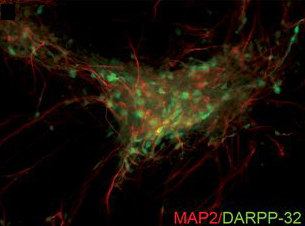Hope for Huntington’s
Posted by Erin M Campbell, on 14 January 2013
 Every time a biologist drives pluripotent cells to differentiate into a specialized cell type, patients of all sorts of diseases, disorders, and injuries allow their hope to grow. A research group recently reported how to drive differentiation of human pluripotent stem cells into medium-sized spiny neurons, the neurons that are some of the first to undergo degeneration in Huntington’s Disease.
Every time a biologist drives pluripotent cells to differentiate into a specialized cell type, patients of all sorts of diseases, disorders, and injuries allow their hope to grow. A research group recently reported how to drive differentiation of human pluripotent stem cells into medium-sized spiny neurons, the neurons that are some of the first to undergo degeneration in Huntington’s Disease.
hPS (human pluripotent stem) cells have the ability to differentiate into countless specific cell types, and can be either human embryonic stem cells or induced pluripotent cells. hPS cells can generate various neuronal cell types, so their use in studying neurological diseases and regenerative therapies for such diseases is notable. Huntington’s disease is an untreatable genetic neurodegenerative disease that typically begins with the degeneration of medium-sized spiny neurons (MSNs), neurons found in the basal ganglia region of the brain. A recent paper in Development describes how hPS cells can be driven to an MSN fate. Carri and colleagues began a combinatorial modulation of the pathways involved, beginning with BMP/TGFβ pathway inhibition. About 20% of the neurons differentiated from hPS cells in these experiments are DARPP-32+/CTIP2+ MSNs also containing dopamine D2 and A2a receptors. These resulting MSNs showed a firing pattern and neuromodulation identical to mature, authentic MSNs. Carri and colleagues transplanted the hPS cell-induced neurons into the striatum of acid-lesioned rats, leading to their in vivo survival and differentiation towards an MSN fate. In the images above, hPS cells were differentiated into neurons that contained DARPP-32 (green), a marker for MSN identity.
For a more general description of this image, see my imaging blog within EuroStemCell, the European stem cell portal.
Carri, A., Onorati, M., Lelos, M., Castiglioni, V., Faedo, A., Menon, R., Camnasio, S., Vuono, R., Spaiardi, P., Talpo, F., Toselli, M., Martino, G., Barker, R., Dunnett, S., Biella, G., & Cattaneo, E. (2012). Developmentally coordinated extrinsic signals drive human pluripotent stem cell differentiation toward authentic DARPP-32+ medium-sized spiny neurons Development, 140 (2), 301-312 DOI: 10.1242/dev.084608
![]()


 (1 votes)
(1 votes)
See also the interview with Roger Barker about this same paper https://thenode.biologists.com/an-interview-with-roger-barker/ , and the videos on EuroStemCell http://www.eurostemcell.org/story/studying-huntingtons-disease-using-stem-cells-lab